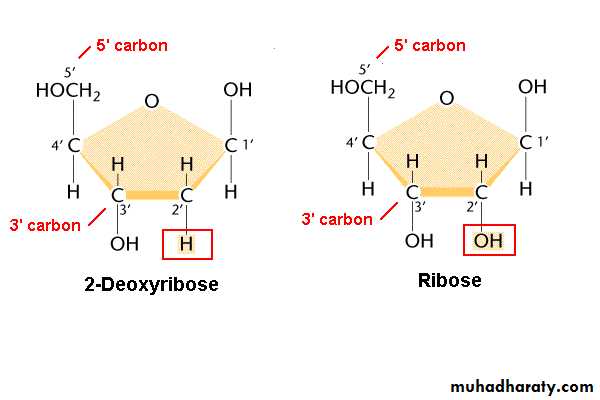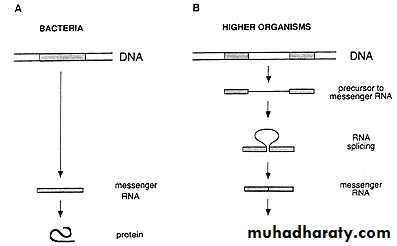بسم الله الرحمن الرحيم
Microbial Genetics
The complete structure of genetic information for a cell is referred to as its genome, this includes plasmids as well as the chromosome; however, the term genome is often used interchangeably with chromosome. The genome of all cells is composed of DNA, but some viruses have an RNA genome.
The functional unit of the genome is a gene.
A gene encodes a product, the gene product, most commonly a protein.The study of the function and transfer of genes is called genetics, whereas the study and analysis of the nucleotide sequence of DNA is called genomics.
DNA as the fundamental element of heredity
According to seminal experiment performedCharacteristics of DNA
Each single strand of DNA is composed of a series of deoxyribonucleotide subunits, more commonly called nucleotides. These are joined in a chain by a covalent bond between the 5' PO4 (5 prime phosphate) group of one nucleotide and the 3'OH (3 prime hydroxyl) group of the next. Joining of the nucleotides in this manner creates a series of alternating sugar and phosphate moieties, called the sugar-phosphate backbone.
Connected to each sugar is one of the nitrogenous bases, an adenine (A), thymine (T), guanine (G), or cytosine (C). Because of the chemical structure of the nucleotides and how they are joined, a single strand of DNA will always have a 5'PO4 group at one end and a 3'OH group at the other. These ends are often referred to as the 5' end and the 3' end and have important implications in DNA and RNA synthesis.
The DNA in a cell usually occurs as a double-stranded, helical structure. The two strands are held together by weak hydrogen bonds between the nitrogenous bases of the opposing strands. The characteristic bonding of A to T and G to C is called base pairing and is fundamental to the remarkable functionality of DNA.
Characteristics of RNA
RNA is in many ways similar to DNA, but with some important exceptions. One difference is that RNA is made up of ribonucleotides rather than deoxynucleotides, although in both cases these are usually referred to simply as nucleotides. Another distinction is that RNA contains the nitrogenous base uracil in place of the thymine found in DNA.Like DNA, RNA consists of a sequence of nucleotides, but RNA usually exists as a single-stranded linear molecule that is much shorter than DNA.
Ribonucleic acid (RNA)
What is RNA, typesA fragment of RNA, a transcript, is synthesized using a region of one of the two strands of DNA as a template. In making the RNA transcript, the same base-pairing rules of DNA apply except uracil, rather than thymine, base-pairs with adenine.
There are three different functional groups of RNA molecules, each one transcribed from different genes. Most genes encode proteins and are transcribed into messenger RNA (mRNA). These molecules are translated during protein synthesis. The information in mRNA is decoded according to the genetic code, which correlates each set of three nucleotides, called a codon, to a particular amino acid. Some genes are never translated into proteins; instead the RNAs themselves are the ultimate products.
These genes encode either ribosomal RNA (rRNA) or transfer RNA (tRNA), each of which plays a different but critical role in protein synthesis.
The Eukaryotic Genome
2- Mitochondria and Chloroplasts DNA3- Many yeast contain an additional genetic element, called as plasmids
1-Eukaryotic genome is carried on two or more linear chromosomes
The Prokaryotic Genome
1- Bacterial chromosome2- (>90%) of prokaryote genome consist of a single circular DNA molecule.
A few bacteria (eg, Brucella,, Burkholderia, and Vibrio cholerae) have genomes consisting of two circular DNA molecules.
3- Many bacteria contain additional genes on plasmids that range in size from several to 100 kbp.
*** 98% of bacterial genomes are coding sequences. ????
• Some bacterial species are causing disease in higher organisms because they possess specific genes that are clustered together in the DNA and are referred to as pathogenicity islands.
• Transposons are genetic elements that contain several genes, including those necessary for their migration from one genetic locus to another.
The short transposons called insertion elements, produces the majority of insertion mutations.
• The replication of bacterial DNA begins at one point and moves in both directions (bidirectional replication).
• In the process, the two old strands of DNA are separated and used as templates to synthesize new strands (semiconservative replication).
• The structure where the two strands are separated and the new synthesis is occurring is referred to as the replication fork.
Replication
• Replication of the bacterial chromosome is controlled, and the number of each chromosomes (when more than one is present) per growing cell falls between one and four.
• The replication of circular double-stranded bacterial DNA begins at the ori locus and involves interactions with several proteins. In E coli, chromosome replication terminates in a region called ter. The two daughter chromosomes are separated, before cell division, so that each progeny cell gets one of the daughter DNAs.
Component
CommentsPrimer
Fragment of nucleic acid to which DNA polymerase can add nucleotides (the enzyme can only add nucleotides to a preexisting fragment).
DNA gyrase
Enzyme that temporarily breaks the strands of DNA, relieving the tension caused by unwinding the two strands of the DNA helix; it is the target of a class of antibacterial medications called fluoroquinolones.
DNA ligase
Enzyme that joins two DNA fragments by forming a covalent bond between the sugar-phosphate residues of adjacent nucleotides.
DNA polymerases
Enzymes that synthesize DNA; they use one strand of DNA as a template to generate the complementary strand. Synthesis always occurs in the 5„ to 3„ direction.
Helicases
Enzymes that unwind the DNA helix ahead of the replication fork.
Okazaki fragment
Nucleic acid fragment generated during discontinuous replication of the lagging strand of DNA. Origin of replication Distinct region of a DNA molecule at which replication is initiated.
Primase
Enzyme that synthesizes small fragments of RNA to serve as primers for DNA synthesis during discontinuous replication of the lagging strand.
Gene expression
1- RNA polymerase forms a single polyribonucleotide strand, called mRNA, using DNA as a template; this process is called transcription. The template strand in the DNA double helix if read in the 3′–5′ direction. Thus, an mRNA is oriented in a 5′–3′ direction.
2- Amino acids are enzymatically activated and transferred to specific adapter molecules of RNA, called tRNA. Each adapter molecule has a triplet of bases (anticodon).
3- mRNA and tRNA come together on the surface of the ribosome. As each tRNA finds its complementary nucleotide triplet on mRNA, the amino acid that it carries is put into peptide linkage with the amino acid of the preceding tRNA molecule.
Start code of mRNA is AUG coded to methionine a.a
Stop codes are UGA, UAA, UAG
Mechanisms of Gene Transfer
Three broad mechanisms mediate efficient movement of DNA between cells:conjugation,
transduction,
and transformation.
Recombination refers to the acquisition of new segments of DNA from the local environment or by another microorganism.
DNA can be transferred from one organism to another, and that DNA can be stably incorporated in the recipient, permanently changing its genetic composition called horizontal gene transfer (HGT)
The transfer of only the of parental genes from parent cell o offspring, a process called vertical gene transfer (VGT).
Conjugation
• is a one-way transfer of genetic material (usually plasmids) from donor to recipient by means of physical contact. Conjugation requires donor cell to-recipient cell contact to transfer only one strand of DNA.
• F plasmid
• R factor
Transduction
phage-mediated genetic recombination in bacteria. DNA is carried by a phage coat and is transferred into the recipient cells.Transformation
The direct uptake of donor DNA by the recipient cell, may be natural or forced.Mutation
is the permanent alteration of the nucleotide sequence of the genome of an organism, virus, or extrachromosomal DNA or other genetic elements.
The spontaneous mutation is a random change in the DNA arising from errors in replication that occur without a known cause.
Induced mutations result from exposure to known mutagens, which are primarily physical or chemical agents that damage DNA and interfere with its functioning
Nucleotide substitutions
Results from mutagenic activity or the mis-pairing of complementary bases during DNA replication. It's often do not significantly disrupt the function of gene products.Frameshift mutations
result from the insertion or deletion of one or two base pairs, disrupting the phase of the triplet-encoded DNA message.
Deletions
are usually large excisions of DNA, dramatically altering the sequence of coded proteins. It may also result in frameshift mutations.Insertions
change genes and their products by integration of new DNA via transposons.
Rearrangements are the result of deletions that remove large portions of genes or even sets of genes.
• The genetic systems (genome) of different living things
StructureVirus
Bacteria
Fungus
Plant
Animal
Human
Nucleus
• -
• -
• +
• +
• +
• +
Nuclear membrane
• -
• -
• +
• +
• +
• +
chromosome
genome
single
multiple
multiple
multiple
multiple
Extra chromosome
• --
Plasmid
Mitochondria
plasmid
chloroplast
mitochondria
mitochondria
mRNA
mature
mature
immature
immature
immature
immature
DNA
• +/-
• +
• +
• +
• +
• +
Intron
• -
• -
• +
• +
• +
• +
Histone
• -
• -
• +
• +
• +
• +


























